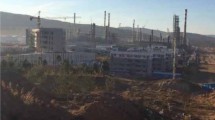Abstract
To study the stability of fill roadbeds for railway-private sidings at the Anning refinery in southwest China, a series of triaxial creep tests of compacted red clay was carried out using an SLB-1 stress–strain controlled triaxial shear permeability tester. In this paper, under different confining pressures, stress levels and drainage conditions, the creep characteristics of the red clay compaction were studied. The results showed that the creep characteristics of compacted red clay were significantly affected by confining pressure, stress level and drainage conditions, and the compacted red clay showed the characteristic of creep attenuation. The stress–strain isochronal curves indicated obvious nonlinear characteristics, which formed a cluster of curves with the uniformization procedure, whereas under drainage conditions, the stress–strain isochronal curves presented a certain linear relationship. Moreover, according to the stress–strain curves, the long-term strength of the compacted red clay was 0.54–0.72 times the instantaneous strength. Furthermore, taking the triaxial creep test of the compacted red clay under a confining pressure of 300 kPa as an example, the data were analyzed, and a new empirical creep model was established. Compared with the Burgers model and the Singh–Mitchell model, the calculated curve of the new empirical creep model is in good agreement with the experimental curve. The new model, which has fewer parameters that are easier to get, has the advantage of a higher accuracy. The new empirical model can better reflect and predict the creep characteristics of compacted red clay in the filling roadbeds of the special railway line at the Anning factory refinery in southwest China.




















Similar content being viewed by others
References
Gidigasu MD (1977) Laterite soil engineering: pedogenesis and engineering principles. Geofisica Intern 17(3):442–444. https://doi.org/10.1016/0016-7061(77)90056-8
Thomas MF, Mcfarlane MJ (1977) Laterite and landscape. Academic Press, London
Kong MK, Zhang LW et al (2016) Experimental investigation on engineering behaviors of red clay under effect of wetting-drying cycles. Rock Soil Mech 37(8):2247–2253. https://doi.org/10.16285/j.rsm.2016.08.016(in Chinese)
Yao YP, Liu L, Wang L et al (2015) Method of calculating creep deformation of high filled embankment. Rock Soil Mech 36:154–158. https://doi.org/10.16285/j.rsm.2015.S1.026(in Chinese)
Zhu C, Li N (2020) Ranking of influence factors and control technologies for the post-construction settlement of loess high-filling embankments. Comput Geotech 118.https://doi.org/10.1016/j.compgeo.2019.103320
Oliveira PJV, Santos SL, Correia AAS, Correia LJ, Lemos L (2019) Numerical prediction of the creep behaviour of an embankment built on soft soils subjected to preloading. Comput Geotech 114:103–140. https://doi.org/10.1016/j.compgeo.2019.103140
Xu L, Coop MR, Zhang M et al (2017) The mechanics of a saturated silty loess and implications for landslides. Eng Geol 236:29–42. https://doi.org/10.1016/j.enggeo.2017.02.021
Jiang MJ, Hu HJ, Peng JB, Leroueil S (2011) Experimental study of two saturated natural soils and their saturated remoulded soils under three consolidated undrained stress paths. Front Architect Civil Eng China 5(2):225–238. https://doi.org/10.1007/s11709-011-0108-8
Ma SK, Huang MS, Hu P (2013) Soil-water characteristics and shear strength in constant water content triaxial tests on Yunnan red clay. J Central South Univ Technol 20(5):1412–1419. https://doi.org/10.1007/s11771-013-1629-1
Svoboda J (2013) Impact of strain rate on the shear strength and pore water pressure generation of clays and sands. Dissertations, Oregon State University
Wang YF, Zhou ZG, Cai ZY (2014) Studies about creep characteristic of silty clay on triaxial drained creep test. Appl Mech Mat 580–583:355–358. https://doi.org/10.4028/www.scientific.net/AMM.580-583.355
Hou SW, Lu DC, Du XL, Xu CS (2010) Analysis and triaxial tests of Beijing clay silt. China Civil Eng J 43:548–553. https://doi.org/10.15951/j.tmgcxb.2010.s1.072(in Chinese)
Zhang ZP, Wang ZY, Peng H (2011) Study on triaxial compression creep test and numerical simulation about mud rock in southern Shaanxi. Hydrogeol Eng Geol 38(1):53–58. https://doi.org/10.3724/SP.J.1077.2011.00271(in Chinese)
Zhao XM, Duan Z, He QF, Song F (2012) Triaxial test on the creep characteristics of Q_2 loess in Yan’an. J Yangtze River Sci Res Instit 29(11):77–81. https://doi.org/10.3969/j.issn.1001-5485.2012.11.017(in Chinese)
Yang CJ, Zhang D (2016) Triaxial creep tests of unsaturated remoulded loess. J Yangtze River Sci Res Instit. https://doi.org/10.11988/ckyyb.20150447(in Chinese)
Wang HF, Fang HB, Zhou LY (2012) The tri-axial creep characteristics test and creep model research of soft clay subgrade. Chin J Undergr Space Eng 860–863:2194–2198. https://doi.org/10.4028/www.scientific.net/AMR.860-863.2194(in Chinese)
Liu X (1994) An introduction to rock rheology. Geological Publishing House, Beijing (in Chinese)
Sun J (1999) Rheology of rock and soil materials and its application in engineering. Chinese Architecture & Building Press, Beijing (in Chinese)
Asefzadeh A, Hashemian L, Bayat A (2017) Characterization of permanent deformation behavior of silty sand subgrade soil under repeated load triaxial tests. Transport Res Record J Transport Res Board 2641:103–110. https://doi.org/10.3141/2641-13
Singh A, Mitchell JK (1968) General stress-strain–time function for soils. J Soil Mech Foundat 94:406–415. https://doi.org/10.1016/0022-4898(68)90146-8
Acknowledgements
The authors gratefully acknowledge the funding support provided by the National Natural Science Foundation of China (Grant No. 51508489) and High-level Talent Gathering Project in Hunan Province (2019RS1059).
Author information
Authors and Affiliations
Corresponding author
Rights and permissions
About this article
Cite this article
Long, Z., Cheng, Y., Yang, G. et al. Study on Triaxial Creep Test and Constitutive Model of Compacted Red Clay. Int J Civ Eng 19, 517–531 (2021). https://doi.org/10.1007/s40999-020-00572-x
Received:
Revised:
Accepted:
Published:
Issue Date:
DOI: https://doi.org/10.1007/s40999-020-00572-x




